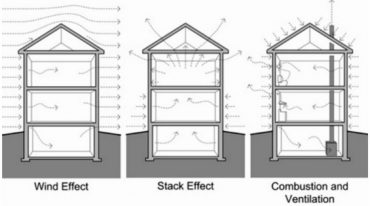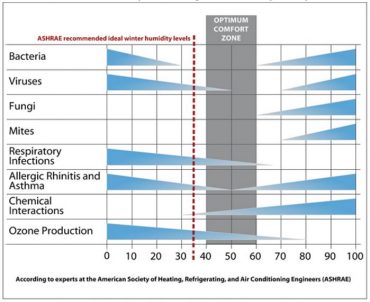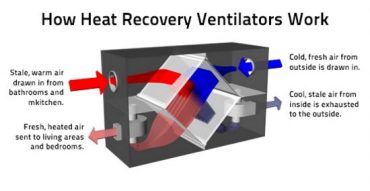
By Grant Walkin
A look at today’s building envelopes (Part 2: Do buildings need to breathe?)
Canadian ContractorInterior building envelope ventilation should occur via a controlled system, not by random chance
Canadian Contractor is pleased to publish the second of three articles by Grant Walkin, a building envelope specialist, focusing on the science behind today’s energy-efficient homes.
A critical question impacting energy savings and indoor comfort is, “How ‘leaky’ is the building?” All buildings leak air, even the most energy efficient, air-tight ones do, to some degree. In fact, I once heard it said, “A building has to breathe”.
Buildings need to be ventilated, true, but this should be in a controlled manner by use of an air exchanger. Buildings should not be constructed with an inferior air barrier that purposely allows air to flow through the envelope uncontrollably. Controlled ventilation through an air exchanger provides a durable, healthy, and energy efficient building. Let’s look at some critical reasons why:

Figure 1: Air infiltration methods on an air leaky building (Home Energy Program, 2016)
1. A leaky building envelope with a poor air barrier, such as improperly installed (ie. non-continuous) house wrap or poly vapour barrier, allows lots of air to filter through the building envelope via walls, roof, and floor. These building envelope components are comprised of dirty materials such as fiberglass insulation. Who wants to breathe that? We should not allow the building’s fabric to filter the air we breathe. After all, there’s a reason why insulation installers wear masks.
2. Air leakage also has a profound effect on the building’s energy performance. A super-insulated building with two feet of insulation will not stay warm in winter if a window is open. The same analogy applies for an air-leaky building. Renowned building scientist Dr. John Straube in his article PA-1203: Air Leaks – How They Waste Energy and Rot Houses (Staube, 2012), suggested that, “one-third of the energy you buy probably leaks through holes in your house”. Stack effect — the upward air pressures caused from the buoyancy of warm air — exasperates air leakage even further during the cold winter months when the temperature differential increases. Figure 1 illustrates the effects of air flows on an air leaky building caused by wind effect, stack effect, and typical combustion and ventilation systems.
3. Buildings are full of air borne pollutants: carbon monoxide/dioxide, volatile organic compounds (VOCs), radon, mold, and other particulates. All these pollutants negatively affect indoor air quality (IAQ). That new home or new carpet smell may be pleasant, but that smell is, in fact, formaldehyde gases and other VOCs. Even old furniture and other household materials continue to give off gas throughout their lifetime. Cooking can also heavily contribute to poor IAQ.

Figure 2: Optimal RH levels by pollutant type for a healthy space (Minotair, n.d.). ASHRAE recommends 35% interior RH in winter for best performance of building envelope and IAQ
The critical importance of the “Comfort Zone”
A useful measurement when screening for IAQ is carbon dioxide, measured in parts per million (ppm). The National Institute for Occupational Safety and Health (NIOSH) recommends the upper limit of good indoor air levels to be 600 ppm, with levels over 1000 ppm being linked to higher complaints of headaches, fatigue, and eye and throat irritation (Occupational Safety and Health Administration, 2016). “Carbon dioxide concentrations in closed or confined rooms can increase to 1000 ppm within 45 minutes of enclosure. For example, in a 11 ft x 13 ft sized office, atmospheric carbon dioxide increased from 500 ppm to over 1000 ppm within 45 minutes of ventilation cessation and closure of windows and doors” (Galera, 2016). The American Society of Heating, Refrigeration, and Air Conditioning Engineers (ASHRAE) recommends a continuous ventilation rate of 7.5 L/s/person (15 cfm/person) to maintain acceptable IAQ levels for a space with an activity level equivalent to an office building (ASHRAE, 2013). A study examining air quality and its relationship to better sleep and next-day alertness found that buildings with either poor or no ventilation routinely had indoor CO2 levels exceeding 2500 ppm. The study further found that sleep and next day performance, “can be significantly improved by increasing the clean outdoor air supply rate in bedrooms” (Strøm-Tejsen, 2016).
4. People inhabit buildings. Water vapour is produced by human activity — perspiration, breathing, cooking, showering, laundry — in surprisingly large amounts! It is important that this accumulation of water vapour be removed in order to control relative humidity (RH) levels, and to prevent mold growth and envelope deterioration. The importance of controlling interior RH levels was discussed in my earlier article in Canadian Contractor, “Air Sealing is King”.
An appropriate and safe RH level to maintain in a home is between 40 and 60 per cent. Figure 2 illustrates how bacteria, viruses, fungi, mites, allergic rhinitis and asthma, and chemical interactions increase as RH levels increase. At the same time, air pollutants increase when RH levels are on the low end. ASHRAE recommends 35 per cent interior RH in winter for best building envelope performance and IAQ. This recommendation is slightly lower than the RH “optimum comfort zone” since it also reduces the risk of interstitial condensation occurring within the wall, which will increase building structure durability.
 The importance of an IAQ control system
The importance of an IAQ control system
Natural ventilation can, of course, be achieved by opening windows. This is easy and effective during the mild months or in mild climates without taking an energy penalty, but what about in winter or at the height of summer? A good solution is to install a controlled and balanced ventilation system that takes stale inside air and exchanges it with fresh outside air. There are systems that recover some of the heat from the exhaust air to the intake air – commonly referred to as an HRV (Heat Recovery Ventilator), or an ERV (Energy Recovery Ventilator). Figure 3 illustrates the basic components of an HRV.
Other ventilation systems that do not include heat recovery can result in large energy penalties, and should be only used for buildings in mild climates. This type of ventilation system includes a commonly used exhaust-only system. Exhaust-only vents are typically found in the kitchen and bathrooms, and push indoor air out. They rely, therefore, on outdoor makeup air to seep in through the cracks in the home for fresh air ventilation. I wonder how “fresh” that fresh air really will be! This system is not typically recommended due to obvious indoor air quality concerns.
Whichever ventilation system is chosen, controlled and balanced ventilation is critical in order to maintain a healthy and durable home. In an old, air-leaky building, an HRV may provide little value. However, the more airtight the building, the more important ventilation becomes. In new construction in Canada, a controlled ventilation system is required. It is highly recommended that this system includes heat recovery.
 Grant Walkin (M.Sc., P.Eng) is a building envelope and structural glass engineer at Entuitive Corp. in Toronto that specializes in commercial, institutional, and residential high performance buildings.
Grant Walkin (M.Sc., P.Eng) is a building envelope and structural glass engineer at Entuitive Corp. in Toronto that specializes in commercial, institutional, and residential high performance buildings.
References
ASHRAE. (2013). Standard 62.1-2013: Ventilation for Acceptable Indoor Air Quality .
Galera. (2016, 12 20). Problems and Solutions of Air Ventilation System. Retrieved from Course Hero: https://www.coursehero.com/file/14523486/problems-and-solutions-of-air-ventilation-system/
Home Energy Program. (2016, 12 20). Stack Effect – Defined. Retrieved from Home Energy Conservation: https://energy.ces.ncsu.edu/stack-effect-defined/
Minotair. (n.d.). Why Ventilate? Retrieved from Minotair The Science of Air: http://www.minotair.com/ventilation/
Occupational Safety and Health Administration. (2016, 12 20). Indoor Air Quality Investigation. Retrieved from United States Department of Labor: https://www.osha.gov/dts/osta/otm/otm_iii/otm_iii_2.html
Primex Fits. (2014, May 8). Why a HRV / ERV Ventilation System is a Smart Investment. Retrieved from Primex Fit everything. Together.: http://www.primexfits.com/hvacventing/hrv-erv-ventilation-system-smart-investment/
Staube, D. J. (2012, October 1). PA-1203: Air Leaks—How They Waste Energy and Rot Houses. Retrieved from Building Science Corporation: https://buildingscience.com/documents/published-articles/pa-air-leaks-how-they-waste-energy-and-rot-houses/view
Strøm-Tejsen, P. Z. (2016). The effects of bedroom air quality on sleep and next-day performance. Indoor Air, Issue 26, 679–686.
Sustainable Homes Ireland. (n.d.). Heat Recovery Ventilation. Retrieved from Sustainable Homes Ireland: http://www.sustainablehomes.ie/energy-insulation/heat-recovery-ventilation/
Advertisement
Print this page

Grant, I want to pick correct vapour barrier for my outside walls. I’m down to the studs on a 1950s cottage. The cottage is in Spring Lake Alberta near Edmonton. It will be vinyl siding then a tyvek the shiplap board then rock wool then this vapour barrier … I just want to buy the right number of mils. I am thinking 6Mils with 6 inch overlap caulked to the wall studs. Can you tell me what your choice would be? I could send pics of my project as I go.